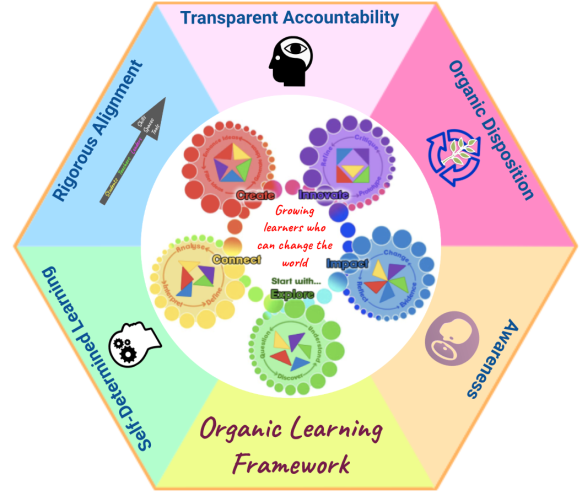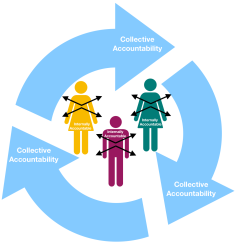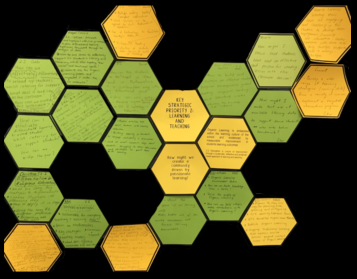
This post is for anyone considering the benefits of pursuing a flatter leadership structure. The ideas put forward have been developed over time during our Organic Learning journey. The particular focus for this post is the first hexagonal section ‘Transparent Accountability‘. Each of the five sections represents a key component for developing flat leadership. Implementing the recommendations from this first section alone is the simplest and quickest way to begin a journey towards developing a flatter structure and the recommendations are not dependent on understanding the Organic Learning Framework. The principles behind the recommendations can be followed regardless of your school-wide pedagogy.
A while ago I wrote a post called It’s Time for Education to Let Go of its Autocratic Accountability Mindset and I referred to the key ideas coming out of Holacracy, which underpins its leadership structure with the belief that ‘order’ does not require ‘a boss’ to direct or maintain it. With the right set of explicit rules, processes, structures, and commitment to a shared end goal, we do not need a boss to tell us what and how to do something.
With this in mind, we looked at how we might create clearly defined structures and processes that empowered teachers to collaboratively take full control of learning (classroom and professional) without having to rely on a ‘top-down’ leadership structure telling them what to do. I have always been annoyed by the propensity for many teachers (and leaders) to rely on being told what to do and when to do it. I believe this type of teacher (and leader) would struggle in a flat structure because the associated mindset is a deeply embedded acceptable norm, particularly in education. This mindset is what we set out to change.
Transparent Accountability relies on the notion of having nowhere to hide. When the expectations, processes and structures are explicit and you continue to make poor choices, lack commitment or hide behind a closed mindset, it is obvious for everyone to see. Therefore to be successful within a community with transparent accountability requires integrity, openness to risk-taking and strong internal accountability, otherwise, you can be found out.
Notice the emphasis on ‘poor choice’, ‘lack of commitment’ and ‘closed mindset’, instead of making a mistake or failing. When we talk about expectations we mean ‘how to be’ not ‘what to do’. Making a mistake and failing is acceptable. Acting with integrity, having initiative, working collaboratively and showing agency are expectations that should form the basis of a deeply embedded acceptable norm.

The same understanding applies to collective accountability. The level of collective accountability is dependent on the strength of each person’s internal accountability. Similarly, if your team has not gelled and lacks cohesion, it is obvious to all the other teams. Again, nowhere to hide.
So how can you work towards achieving this? There are three strategies you could explore. Each in isolation will achieve significant success, but when implemented gradually and consecutively, great developments and mind shifts can occur.
Hexagonal Curriculum Mapping
Hexagonal Curriculum Mapping is a creative planning process for developing transdisciplinary units of learning based on the clustering of cross-curricula outcomes and making it visible on a shared learning wall. It establishes the expectation for teachers collaborating in teams. The depth and rigour of planning are on show for everyone to see, comment on and critique. It takes programs and the thought process behind them out of a computer or folder and externalises them on a wall. Nowhere to hide.

Not only will teachers be excited and motivated by this creative process, but they will begin to experience the subtle pressure of transparent accountability because other teachers will look at each other’s cluster of outcomes and compare it to what they would do (a natural consequence). This is healthy because it leads to more creative dialogue and ‘thinking outside the box’, which is exactly what you want to happen. Hexagonal Curriculum Mapping will help your teachers move away from ‘let’s do Transport’ or ‘Antarctica’ because ‘that is what we always do’ to ‘what exciting learning experiences can we create for our students?’
Pitch & Critique
The Pitch & Critique strategy establishes a collaborative mindset for open and transparent feedback between learners. It is a strategy used by students and teachers which strengthens our drive for the alignment of learning tools and strategies across a community. In this instance, it is used during the Hexagonal Curriculum Mapping process. When a team has finalised its planning prototype, it is pitched using a Pitch & Critique Protocol to another team, who then provides provocative feedback. From here the team writes and implements a unit of work.
After approximately four weeks, the team reflects on its progress and summarises the initial intention, what has been achieved so far, and what is planned next, in order to meet the desired impact. The team engages in another Pitch & Critique with a different team for feedback. Once again there is nowhere to hide. If your program has been substandard or your plan to bring it home is off the mark, it is plain for all to see. This is when individuals put pressure on each other to maintain strong collective accountability. The pressure does not come from the school leaders nor do the leaders have to hold any individual accountable. They do it themselves.
A team will often use this process to help find a better solution for the unit of work. A real highlight is that all teams become intimate with each other’s program and the sharing of knowledge, skills and expertise is fluid between teachers of different stages or grade level.
Professional Learning Goals
Organic Professional Learning is the cycle of learning used by teachers whilst engaging in lifelong learning as professionals. There is no ‘one way’ to engage in Organic Professional Learning and the depth of engagement is up to each individual. The expectation is that there must be a purpose for learning and teachers have to be ‘model learners’ who continually learn, fail, take risks and grow. The same applies to leaders as it is vital for them to demonstrate their capacity as ‘Lead Learners’.

To emphasise the value of transparency, each teacher’s personal learning intentions are made visible in the staff learning space, similar to Hexagonal Curriculum Mapping. In this way, everyone knows what everyone else is doing in terms of their own professional goals. Groups of teachers can team up and work collaboratively or individuals could support others who are working on an area in which they already have expertise. And to really increase internal accountability, teachers engage in Pitch & Critiques throughout the year. There is no pressure from the leaders as the teachers hold themselves and each other accountable.
How do these help you move towards a flatter leadership structure?
Each of the strategies – Hexagonal Curriculum Mapping (externalising planning), Pitch & Critique (open transparent feedback), and Professional Learning Goals (externalising personal/professional goals), impels teachers into a transparent culture. As these become the norm, we have found teachers begin to demonstrate greater internal accountability and personal leadership. They can be creative, feel less anxiety at being critiqued and be more open about where they are in their own learning journey. For some, it is either sink or swim, but we have found most swim.
Strong internal and collective accountability is crucial for developing flatter leadership. Ultimately, flatter leadership implies everyone sees themselves as a leader or their team as a leading group. Critical to these strategies is the participation of the school leadership team. Everyone must participate fully, engage in every component, share in and be open to the provocative feedback. The leadership team, including the principal, must lead ‘with’ the teachers, otherwise the community will fall short of full alignment and the processes become ‘top-down’. A ‘you do it and I will observe from the side’ leadership style is not conducive to a flat structure. So even for the principal, there is nowhere to hide and the lack of engagement will be observed by all.
If you are not sure how to begin the Hexagonal Curriculum Mapping journey, contact us. We are happy to assist in whatever way we can.